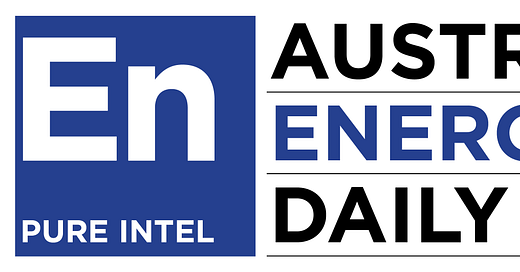Day 46: An energy 'superpower'
An introductory weekday newsletter from Schwartz Media. Counting the days since Australia had an energy policy.

Good morning and welcome to day 46.
Today in summary: Renewables exports could take the place of Australia’s lucrative thermal coal exports, said Labor frontbencher Pat Conroy (assuming we have a settled energy policy); buzz is building ahead of Monday’s IPCC report on limiting global warming to 1.5°C; and a NSW energy pricing regulator has flagged problems with default pricing.
— Charis
Today’s policy spin level: 💨💨💨
Australia can remain an energy export “superpower” by replacing declining thermal coal exports with exports of wind and solar, argues Shadow Assistant Minister for Climate Change and Energy Pat Conroy.
“As the world decarbonises its electricity supply, the nations that can transform into manufacturing powerhouses are those with the cheapest energy, which will be the nations with the best renewable energy resources.”
Conroy is also bullish on Australia playing a major role in renewables inputs.
“We are the second-largest producer of rare earths, we supply 41% of the world’s lithium and we have 12.4% of global copper reserves. These are all crucial materials for clean energy and battery manufacture.”
In what’s been dubbed “the biggest peer-review exercise there is,” a herd of 50 scientists are busy finalising the wording on the long-awaited Intergovernmental Panel on Climate Change special report on limiting global warming to 1.5°C.
The report will be published at noon AEST on Monday and will outline where the world is and what’s still required to prevent dangerous levels of global warming. It will also spell out what’s likely to happen should warming be headed for 2.0°C, compared with 1.5°C.
Leaked drafts of the report suggest renewable energy use would need to rise by 60% between 2020 and 2050, and primary energy from coal would need to decrease by two-thirds in order for the world to meet the 1.5°C goal. The world has warmed almost 1.0°C since the start of the industrial revolution in the early 1800s, and the IPCC is predicting with “high confidence” that we’ll go past the 1.5°C market by 2040.
“In energy systems a 1.5 degree consistent pathway includes a substantial reduction in energy demand, and a decline in the carbon intensity of electricity to zero by mid-century,” the draft reportedly says.A default electricity price could reduce competition and lead to higher prices in the longer term, according to NSW regulator the Independent Pricing and Regulatory Tribunal.
The ACCC recommended “default standing offers” to cap electricity prices in its enquiry into electricity prices, a move supported by Energy Minister Angus Taylor. The tribunal says a default tariff could help in the short-term by preventing disengaged customers paying excessive prices, but over time is likely to make customers more complacent, with less customers shopping around and fewer retailers competing in the market to serve them. Instead, it suggests a benchmark that would not be enforced, but that customers could compare their rate against.“The most effective way of limiting further energy price increases in the future is to provide conditions that encourage new investment in the wholesale market to increase supply and replace existing generation, as they reach the end of their asset lives. This means providing a stable and predictable investment environment.”
The Commentariat
Australia can expect another energy crisis by Christmas, writes the Australian Financial Review’s Jennifer Hewett.
“For an industry still feverishly looking for the illusion of policy certainty, the Coalition under Morrison is promising to maintain the rest of the NEG's original framework...
But none of it directly addresses the even greater illusion – that this will produce the reality of lower prices that can be convincingly spruiked in time for an election.”
The risk of a global energy shock is rising, writes the Sydney Morning Herald’s Stephen Bartholomeusz, thanks to looming US sanctions on Iran and a rising US dollar.
“Trump, who sometimes appears to have trouble seeing the relationship between cause (his sanctions) and effect (the soaring oil price) has accused OPEC of ‘’ripping off’’ the rest of the world.
“With the November mid-term elections looming in the US the spike in gasoline prices – they are about 25 per cent higher than a year ago – has a political dimension to it that may see the Trump rhetoric, and threats, become louder.”
Three more things
People living in regional and rural NSW are paying up to A$1,000 more for power a year than those living in the city, according to St Vincent de Paul's annual electricity report. Although higher regional prices are driven by less competition, the NSW Independent Pricing and Regulatory Tribunal says the gap between the cheapest and highest price deals is growing.
Sydney Morning Herald
The ACT government is calling for industry input on a waste-to-energy policy for the territory. “We want our community and industry to be partners in co-designing a long-term, informed and evidence based policy,” said Minister for City Services Chris Steel. Consultation closes on November 27.
The US Department of Energy’s (DOE) Argonne National Laboratory is experimenting with machine learning to help improve system reliability. Any breakthroughs in optimising the US electricity grid will however, require more data. “It would require the integration of more sensors on components like solar panels and wind turbines, input from more advanced weather radars and sensors, and the ability to effectively analyze all of this data to maximize the use of distributed energy resources.”
Renewable Energy World
This is an introductory service while we’re building a comprehensive daily paid online publication, coming in early 2019.
We’re not here to take sides, simply to cut through the noise, and help you make sense of the emerging policy and market trends you need to be across. We call it pure intel. You can read more about us here.


